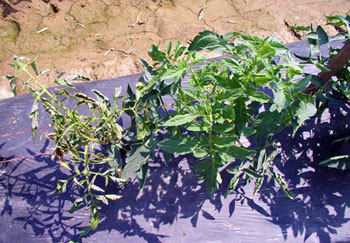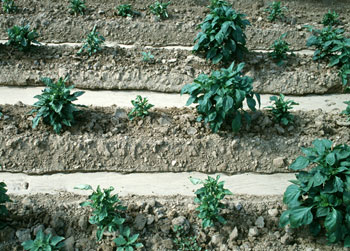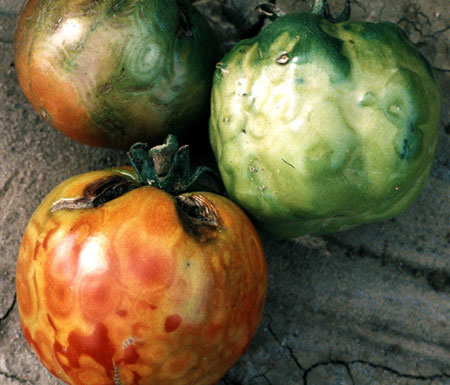Tomato spotted wilt can be a northern vegetable problem
Tomato spotted wilt virus is a devastating disease affecting numerous crop and non-crop species, but is typically not a problem of northern states. So why does it appear in some northern vegetable plantings?
Tomato spotted wilt virus (TSWV) can infect over 1,000 plant species and is capable of causing significant economic damage to many field and horticultural crops and weed species. Like many virus diseases, TSWV needs a vector to move from plant-to-plant. Many thrips species act as the vector, but the most important is western flower thrips. TSWV also infects the vector, meaning once thrips acquire TSWV it continues in their systems and makes them capable of transmitting the disease throughout their life.
TSWV stunts plant growth and deforms fruit (Photos 1-3). Infected plants will never have economic yield and infected fruit is unmarketable. Early symptoms can appear as if the plants have been stunted by herbicide drift.


TSWV-infected tomato (left) and pepper (right) plants showing severe stunting caused by TSWV
infection compared to healthy plants. Photo credits: George Kelley, University of Kentucky (left) and Whitney Cranshaw, Colorado
State University (right)

TSWV symptoms on tomato fruit. Photo credit: Whitney Cranshaw, Colorado
State University
TSWV is a common problem in southern states in tomatoes, peppers and other vegetable crops, but is rarely a field problem in these crops for northern growers. The reason it may not be a field problem in northern climates is western flower thrips do not survive our winters well. However, greenhouses with year-round production of ornamentals provide the environment for western flower thrips to survive. Vegetable transplants grown in a greenhouse not having good western flower thrip management can acquire TSWV.
There are TSWV-tolerant vegetable varieties, but they are more adapted to southern growing conditions. The best way to control TSWV in the north is prevention. Many ornamental producers have stopped growing vegetable transplants due to the high probability of transmission. If they still produce vegetable transplants, many dedicate a house only to production of those transplants. Since adult thrips can fly, there is risk of transmission from house-to-house. They can also move on worker’s clothes.
A good sanitation program includes elimination of weeds under benches and removal of all plant material from the greenhouse between crops. Always test susceptible plants by sending samples to a testing lab or use testing strips. Read the MSU Extension article Questioning a virus in your greenhouse crop? for more information on test strips.
At the minimum, make sure your transplant producer does not have ornamentals in the same house as your transplants. If you are a transplant producer, it is possible you could be getting TSWV from your plant source. So if you purchase transplants from numerous suppliers, keep track of where your plants came from so you can do a trace back procedure. That way you could determine if it is a problem from your plug supplier or in your own greenhouse.
For more information on TSWV
- Vegetable MD Online: Tomato spotted wilt virus, Cornell University
- Tomato spotted wilt virus, APSnet.org
- Greenhouse Plant Viruses (TSWV/INSV), Colorado State University Extension



 Print
Print Email
Email

